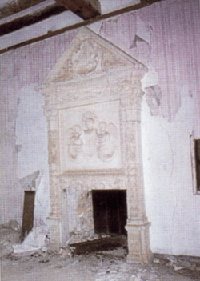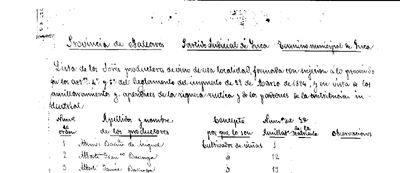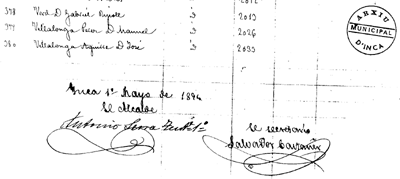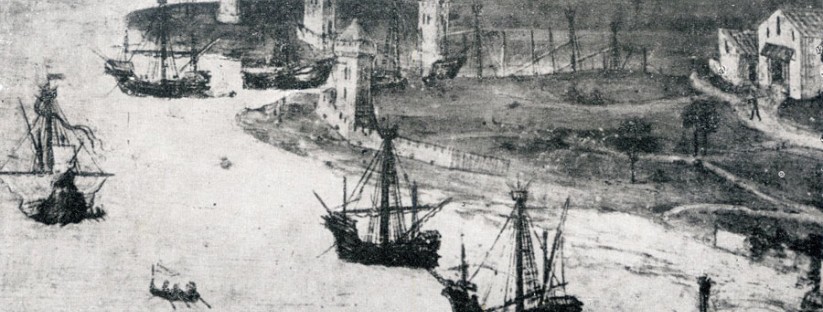19th century
Dn. Joan Baptista de Bordils i Tamarit died in 1808 without issue. Much of its assets, Son Bordils, Albarca, Cosconar, Tossals Verds, Cuber, is Rafal, Red Creek, sa Grotto, the font de'n Villalonga de Sóller, a horse in Felanitx, 'censuses i Alous' several towns and properties in Palma, went to the 'Brotherhood of Sant Pere i san Bernat' (Gran Enciclopedia de Mallorca, Vol. II, page 207 ff.). In the text of Ayreflor Ramis (Ramis Ayreflor and Sureda, J., Bolletí Luliana the Archaeological Society, 1905), says: "He died unmarried in 1808, inheriting much of his free goods Brotherhood of San Pedro and San Bernardo ".
However, both the townhouse Palma known as Can Bordils, as the estate of Inca Son Bordils, passed to the son of his niece Catherine Ma., Dn. María Martín Boneo Villalonga Bordils. Dn. Martin was the firstborn of the children of the marriage gotten Ms. Catherine Maria de Villalonga Bordils of Vallés and Tamarit, daughter of Ms. Eleanor of Bordils and Tamarit, which in turn was the sister of former owner of Son Bordils, and his cousin Dan. Boneo Antonio Villalonga Brondo and Vallés. Marriage had three children: Antonio, Jerónima and Dn. Francisco, who married Ms. Margarita Font i Busquets.
Dn. María Martín Boneo Bordils Villalonga, was born in 1784, joined the Guard Navy in 1798 and served it in different boats and squares as lieutenant of the Royal Navy until 1808, when he died dn. Joan Bautista returned to Mallorca, and retired from service the following year. In the following years he was alderman of the City of Palma (1834), Member of Parliament for the game Inca (1835), Partner number of the Majorcan Economic Friends of the Country (1835), Acting Regidor de Palma (1850) and Caballero of the Order of Santiago. He died unmarried in 1852. (Enseñat of Villalonga, A., "The Family Boneo de Mallorca").
He must enjoy great wealth Dn. Martin Mary and that in his time were carried out major reforms in the urban house Palma, who was then known by Can Boneo and mainly affected the façade (Pascual, A. in "La Casa and Time", 1999 ), as in the cases of Finca Son Bordils, building the current south of the façade, covering it with lime mortar. Dice Rayó (Rayó Bennàssar, P., in "The Son Bordils Possessió i el seu entorn" Dijous Program Bó, 1995), referring to the latter reform:
 També a l'interior les cases, highlights a Xemeneia of segle XVI, located on the first pee, molt possiblement traslladada in aquest lloc, during the XIX segle, per the Boneo-Villalonga família, època that is reformaren marry them.
També a l'interior les cases, highlights a Xemeneia of segle XVI, located on the first pee, molt possiblement traslladada in aquest lloc, during the XIX segle, per the Boneo-Villalonga família, època that is reformaren marry them.
Another significant finding is apparent from the comparison of the Inca cadastres the years 1818 and 1860. While in the Apeo of the town of Inca, built in 1818, known Apeo de Garay and consisting Martin Boneyo as owner indicated are the surface is 371 Bordils quarteradas, ie, 263 Ha, of which only 24 q. appear as 'vinya third qualitat'; in the land of 1860, eight years after his death, collected by the Archduke in his work Die Balearen (Archduke of Austria:. 'The Balearic by word and engraving' Palma de Mallorca, 1987, Volume V) Son Bordils is the largest field near to Inca with an area of 604 ha., is the largest producer of cereals and legumes, and one of its three largest producers of wine.
Dn. María Martín Boneo Bordils Villalonga, dead his brother Dan. Boneo Francisco Villalonga Villalonga Bordils five years before, and once made other bequests, named 'usufructuary heir to his cousin Don Francisco Mariano Villalonga and Climbing and owner to his son Don Manuel Villalonga Pérez'.
The marriage of Dn. . Francesc Mariano de Villalonga-Escalada, brother of the mother of Mr. Martin Mary, with Mrs. Carmen Perez de Escalada, had two sons: the eldest, Dn. Antonio, who was then the owner of the house Can Palma Escalades until its sale in 1891, and Dn. Manuel, heir Owner Dan. Mary Martin.
While his father was a usufructuary heir Son Bordils, Dn married. Manuel Perez Villalonga and his second cousin and niece of Dn. Mary Martin, Ms. Emilia Boneo i Font, universal heir of the property from their parents Dn. Boneo Francisco Villalonga Villalonga Bordils brother Dan. Mary Martin and Ms. Margarita Font i Busquets.
Dn. Manuel de Villalonga and Perez was Regidor trustee of the City of Palma (1865), "... and when in the same year the city was invaded by cholera morbidity Asia, was one of the few who did not leave the city '(Vilar and Pascual, L., Yearbook of the Spanish nobility, p. 334, 1880). In the obituary you wrote Criado (Criado and Dominguez, JP, The Red Cross, 1914), describes it:
As this most excellent Councilman Hall was one of the few who remained in Palma during the 1865 cholera in the city was completely abandoned. Since then, only I was fifteen, I admired the feelings that lay in his noble soul. seeing him go to all parts where I could render assistance and dry a tear ... How many times accompanied the Hospital of the Market (provisional and in the former headquarters of National Militia which no longer exists), together with the illustrious Bishop Salvá . The poor patients abandoned by their families, with tears in his eyes, thanked her care.
He was named second deputy Mayor de Palma (1866) until it was replaced by the revolution in 1868. From his marriage to Mrs. Emilia Boneo and Font had five children. Firstborn Francisco, Emilio José Manuel Martín, Leonor and Maria del Carmen.
The nineteenth century was a century Inca considered for recovery and splendor for traditional crops of grapes and olives. The vineyard area under cultivation increased from 430 ha. In 1819 to 504 ha. In 1860, and 847 ha. In 1875. They had overcome aphid pests in 1834 and powdery mildew in 1851.
According Stang (p. 33), in 1860 there were planted throughout Mallorca 15,543 Ha. Vine, which as we said, 504 Ha. Belonging to Inca, 3.24% of the total. Around this time, spent the Archduke of Austria for the farm. In Die Balearen describes it:
From Muro is down the other side of the valley, with a beautiful view over the 'Colls'. The houses stand between cacti and carob, are shaded by oaks and heights ranging from gently lowering the vineyards.
Passing through a coated remontorio Mastic get to 'Jornets' village located 2 km from Muro, with 179 neighbors. Has a public oratory dedicated to San José dating from the last century, to the right is the large possesió of 'Son Bordil'
The book of G. Pieras (Pieras G., 1995) entitled "Inca 1872" allows an accurate portrayal of Inca late nineteenth century. Inca had already regained its lost glory in the seventeenth century and was again the second city of the island with a population of 6,034 inhabitants. In 1872, in Inca 47% of the working population engaged in the primary sector, 37% in the secondary sector and 16% in the tertiary sector. It was therefore preferably setting, but with an important artisanal sector; prelude to further industrial development. As for the wine, the number of "cellars i Bodegues" existing in the urban population in 1872 was already 29 and had 23 "botigues that venen saw the little"; which gives an idea of the recovery that had gotten back Inca commerce in wine.
The splendor and had lost Inca hegemony in the seventeenth century, had been recovered in the late nineteenth century. Again had considerable vineyard surface and was again the capital of the island winemaking and wine trade.

In 1873, the same year he was appointed President of the Assembly of the Balearic Red Cross, Dn. Manuel Perez Villalonga and signed the acquisition of the property by way of inheritance, three years before he died his father, Dan. Mariano Francesc de Villalonga-Escalada, an eminent bibliophile and heir beneficial owner of Son Bordils for 21 years. In the scriptures that confirm the facts, the total area of the farm, probably because it was unknown, but comprise other data that give a good idea of its extent is not mentioned.
Description: "Premises named Son Bordils with their aggregates Son Mas and S'Hostalet located at the end of this town of Inca." "It is crossed by the road from Inca to Sineu"
boundaries:
North: "With the finca Can Llarch with land ... with the path of the Wall, with Hostalet and Son Ramis farms"
South, "with the addition that called Son Tomaset be described by Torrente"
This "with path setters, with Llubi and the Corbera, Corberasa and rock properties"
West: "José Bordils and local road"
Dn. Villalonga i Manuel Pérez not only inherited a number of assets: "... the great possession, called Son Bordils, which lies in the towns of Inca and Muro, the house call Bordils, with historic arch Almudaina and other '(Vilar and Pascual, L., Yearbook of the Spanish nobility, page 334, 1880.); but also an important monetary amount, '... be also owned by the same title, the amount of eight hundred thousand pounds shutters, coming from the sale of the property Farmhouse Fosca in Campos, who was part of the expressed inheritance, amount thereof with interest accrued and not paid, it must Dn. ... '. However, it remains curious and significant that among the loads of the property listed, has' a mortgage for eight thousand eight hundred thirty-two pounds salary nine funds imposed by Don Manuel Villalonga Pérez for his Doña Emilia consort Boneo, ... ", as collateral for the same amount from the dowry of this (Scripture acquisition of the property by way of inheritance, 1873).
Dn. Villalonga i Manuel Pérez was the great promoter of wine Son Bordils development of the last third of the nineteenth century. When Rayó (Rayó Bennàssar, P., in "The Son Bordils Possessió i el seu entorn" Dijous Program Bó, 1995) describes the north facade of the cases of Son Bordils, which reads:
The façana nord, d'one level, feta based col.locades pedres amb morter, tea cantonades pedra them alive. Hi highlights the great portal arpanell i amb arc dovelles marès PUE permet enter a pati tancat celler i pel the cups, els quals demostren the great importance guishes the cultiu of vinya Son Bordils, sobretot in tert darrer the XIX segle . The celler és ben l'month conservat architectural element of possessió. This recobert per voltes d'aresta that s'aguantan on ortogonals pilasters amb base.
In 1875, the train arrives at Son Bordils, which has built the "Estació del Empalme", also called the "Son Bordils station". In 1899, and no doubt for this reason, "... it is inside the premises of this perpetual easement part number (which begins the road to Sancellas and the point called Sa Bassa Seca and ..) is created Corbera favor of land ... and for the farm also called the Rock ... "; that today constitute the way usual access of these two farms and runs parallel for a good stretch, to the train tracks.
Given that between 1860 and 1890, the area under vines nearly doubled throughout the island, reaching 30,000 ha. In 1890, and that the census of vineyards registered Inca in 1875 it was 847 ha., It is likely the number of hectares devoted to vineyards in Inca in 1890 out of about 1,000 ha .; approximately one sixth of the total area of the municipality.
1890 is the year top of the Mallorcan wine; never reached since. The 30,000 ha. Cultivated vineyard 750,000 Hl bore fruit wine. Much of the wine produced in those times was exported to France via the ports of Palma and Felanitx (Porto Colom), where cost effective prices given the shortfall as a result of the attack of phylloxera who had suffered in 1861 were paid almost 30 years before. However, the euphoria was over because France already had more than 125,000 hectares replanted with American rootstock resistant to phylloxera, and was determined to implement protectionist measures for the production of its vineyards.
A year later, in 1891, appeared in Mallorca phylloxera, devastating vineyards throughout the island. In just ten years, from 1890-1900, the area occupied by vineyards went from 30,000 to 2,000 hectares .; ie approximately desaparecieron14 times the size of existing vid today and 93% of existing vineyard before the attack of phylloxera.
Pico relates (p. 32): 'The invasion is detected, the May 20, 1891 in Llucmajor and Algaida. Their presence is withering. In one year it was extended to seven municipalities. All wealth comes down wine. The Island is greatly affected. Some wine is still exported, but is decreasing. In one year, exports fell by half. (sic). The vineyard had lost the battle, and repopulation was made based on almonds'.
In an Act of the Full Council of Inca day June 10, 1891 (see copy of the original), which met under the chairmanship of Mayor Dan. Matías Pujadas, the arrangement is published in the "Official Gazette number 3798 ', which appears in the margin of the Act, with the inscription' Phylloxera '. It reads:
A circular from the Governor of the province, stating that according to opinion of voluntary Commission has come to recognize different vineyards reported by sickly had gotten invaded by the Phylloxera extensive territory of the term of Llucmajor, which is why ... the zeal of the Messrs. Mayors to intensify surveillance and immune seek to preserve their municipalities, Dictating to effect the proper precautions, with several other rules to be observed in the unfortunate event of invasion whose local committees should be appointed who will travel constantly monitoring the vineyards. In his view was given by the Corporation aware arranging his most timely and ... compliance especially for being as terrible as harmful pest.
Although Dn. Manuel Perez Villalonga and other productive sectors you were probably introduced by the previous owner, Dan. Martin Mary, almond and higueral and the other sector where it was the largest producer of Inca: the cultivation of cereals and legumes; the phylloxera should assume the interruption of the wine industry of the estate; ie the disappearance of vineyards and stalling few years old celler activity Son Bordils, which he had so spectacularly renovated in the years of opulence sector. Definitely a blow to Son Bordils, who had led the company which was the first Inca productive sector, the primary sector, for much of the last half of the nineteenth century.
Although phylloxera, three years later, ie in 1894, the number of growers surveyed in Inca is extremely high: 380 people, with their names and their corresponding ". Num of Amillorament" appear in the list Messrs. winemakers of this town made subject to what is provided in Sections 4 and 6 of Regulation tax March 29, 1894, and in view of the amilloramientos and appendices of rustic wealth and standards of the Industrial contribution. Besides the "Num. Of Amillorament" include the order number, surname and name of producers and Concept why they are.

Interestingly, all of them are included in the census in concept grower vineyards. In the list alphabetically by last name producers, appears in last place and, therefore, with the number 379, Dn. Villalonga Manuel Perez, who was the owner at the time of Son Bordils, by way of "vine grower", accounting for "Num. Of Amillorament" 2026.

On 19 ferero the last year (1900) century, starred Dn. Manuel, accompanied by his son Dan. Emilio, a heroic rescue of shipwrecked sailboat Sebastiano in the waters of Molinar episode so I was honored by the Society of Lifeboat. Entitled A hero of Charity: Don Manuel de Villalonga, the Deputy Secretary of the Red Cross, Mr. Calvo, presented it well in an act of that Assembly, which was collected by the Bulletin of the Red Cross:
Our readers know. This distinguished and octogenarian President of our provincial Commission of Palma de Mallorca, with undaunted courage that even in younger years caused admiration and amazement, braved the dangers of the raging sea by imponentísima storm, achieving save from a horrible death to some unhappy shipwrecked today bless his name

